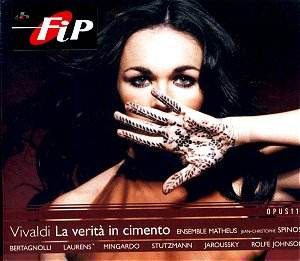Vivaldi's
opera La verità in cimento was first performed in
Venice in 1720 in the small Teatro S. Angelo. Competition was
rife, and Vivaldi could not secure one of the larger theaters
for the performance. This work was controversial, and led to a
polemic between those who wanted a more conservative form of opera
to continue, and those, such as Vivaldi, who had a new vision.
Yet this controversy helped La verità in cimento be
a success, not only in Venice, but also throughout Europe. Of
all Vivaldi's operas, none is found in more copies in European
libraries.
The
first thing that surprises in this recording is the proximity
of the soloists in the soundscape. After an opening sinfonia in
three movements, where the orchestra is heard as in a hall or
church, the opening recitative sounds as though the singer were
in your living room. All the vocalists are this close during the
recitatives, which is a bit disconcerting. When singing arias
they sound as if they took a few steps back to let the orchestra
through. But overall the sound is disappointing.
The
Ensemble Matheus joins here with an interesting group of soloists,
but disappointments abound. Contralto Nathalie Stutzmann has an
attractive, dark voice, but wavers too much, and her vibrato seems
to flow against the music. Unfortunately, this vibrato seems to
be contagious - Gemma Bertagnoli, who is in fine voice in spite
of this, overdoes it as well. Given the small orchestra backing
up these singers, the vibrato stands out far too much.
Counter-tenor
Philppe Jaroussky is excellent, and his first aria, Tu m'offendi,
is one of the finest numbers in this work. Jaroussky has a very
feminine sounding voice, which fits well with the high range of
this aria. Anthony Rolfe Johnson is excellent as Mamud; his aria
Vinta a pie d'un dolce affeto, in act 2, is one of the
high points of the recording. He combines a strong voice with
subtle phrasing, which, together with the driving accompaniment,
is memorable.
Another
admirable moment is the quintet at the end of the second act.
It is always difficult to have so many soloists work together
so perfectly, but their voices meld and flow like honey in this
fine piece.
The
orchestra is effective and sounds good, though the recitative
accompaniments sound strange - sometimes harsh, sometimes too
distant, they don't seem to accord with the soloists at this time.
But when backing the singers in their arias, the orchestra is
well balanced and incisive though perhaps too much for some tastes.
There are many sharp edges; this music could do with a bit of
softening and subtlety.
All
this adds up to a recording that will please some and irk others.
This is fine music, but the performances are not ideal. This is
the only currently available recording of this work so Vivaldi
fans will want to snap it up. Unfortunately it is not as good
as some of the other excellent recordings that Opus 111 has released
in their Vivaldi series.
Kirk
McElhearn
